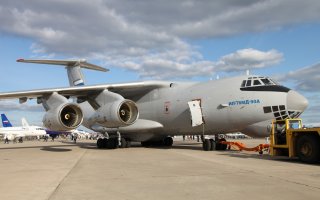Is Russia's A-100 Airborne Early Warning and Control Plane Over-Hyped?
The A-100 has some major theoretical advantages over America's E-3 Sentry.
Here's What You Need to Know: The A-100 will provide the Russian Air Force with a modern, effective AEW&C aircraft, but it’s unlikely to be much better than its foreign competitors.
While radars on fighters have been getting more and more powerful, dedicated airborne early warning and control (AEW&C) aircraft are still a necessity for most air forces to be competitive in aerial warfare. While the USAF continues to use upgraded versions of the E-3 Sentry, built on the airframe of the venerable Boeing 707, Russia is currently developing the A-100 AEW&C aircraft, which is built on the latest version of Ilyushin Il-76 military transport aircraft. However, the A-100 sports an active electronically-scanned array radar (AESA) in its rotating radome, in contrast to the E-3’s passive electronically-scanned array (PESA).
But does the new airframe provide the A-100 significant advantages of the American E-3 Sentry? How big of a deal is the AESA vs the PESA array?
Starting with the radar, the A-100 has some major theoretical advantages over the E-3 Sentry. While six revolutions per minute (RPM) has been the standard rotation rate for most AEW&C aircraft with rotating radomes (the earlier A-50, E-3 Sentry, and Japanese AEW&C all rotate at this rate), the A-100 cranks this up to twelve revolutions per minute. This allows for a faster “refresh rate” on tracking targets. Also, because the A-100 is an AESA, it has the capability to output multiple scanning beams to look for a target, while the E-3’s PESA is only limited to one.
The AESA vs. PESA capability gap is often overstated though, and the E-3 saw its own PESA radar get a major upgrade in the RSIP package around the turn of the century. But other recent AEW&C aircraft such as the E-7 “Wedgetail” feature flat, non-rotating AESA radars, so in a way, the A-100’s radar may already be behind the latest Western designs. The U.S. Air Force’s canceled next-generation AEW&C aircraft, the E-10, was said to use a variant of the Wedgetail radar.
As missiles get faster, the almost-instant refresh rate of the Wedgetail’s fixed AESA will become more important. At six RPM, a single track may go ten seconds before being picked up again on radar. For a hypersonic missile going Mach 7 (ignoring the possible plasma shielding effects that hypersonic missiles bring), a missile could go twenty-four kilometers before being picked up again. At twelve, this is reduced to half that, but flat AESAs can keep track of such threats in near real-time (provided they can be detected to begin with.
However, AESAs do lose power the further they are asked to track from the normal (perpendicular vector) of the radar surface. While this can be mitigated by smart flying of an AEW&C aircraft, full power emission on all 360 degrees is not possible.
Russian sources have also hyped up the A-100’s capability to track ground and sea targets. While AEW&C aircraft are capable of such a role, the positioning of the antenna above the airframe on the A-100 makes it suboptimal for such a role. Purpose build airborne ground-surveillance aircraft like the E-8 JSTARS feature antennas under the airframe, and the A-100 has no such antenna.
But what about the airframe? The A-100 is based on the latest variant of the IL-76, the Il-76MD-90, which is can be considered a “heavy” variant of the Il-76. The increased carrying capacity of the aircraft goes towards the new avionics, radars, and computers in the A-100. The upgrade also features improved engines that are more fuel-efficient and a glass cockpit to make the aircraft easier to fly for pilots. But the E-3 has received similar upgrades, albeit in the form of retrofits to the old Boeing 707 airframes. The actual flight characteristics of the E-3 and the A-100 are still similar, with the E-3 even edging out the A-100 in range (9250 km vs 8500 km, per Russian sources).
While the A-100 will provide the Russian Air Force with a modern, effective AEW&C aircraft, it’s unlikely to be much better than its foreign competitors. The A-100’s reliance on a rotating radome when recent Western aircraft have switched to a static AESA array is also puzzling. Either this was a move by the traditionalists in the Russian Air Force, or Russian industry is unable to produce a static AESA array package similar to that being used by the E-7 Wedgetail.
Charlie Gao studied political and computer science at Grinnell College and is a frequent commentator on defense and national security issues.
This article first appeared in September 2019.
Image: Wikimedia Commons / Vitaly V. Kuzmin

